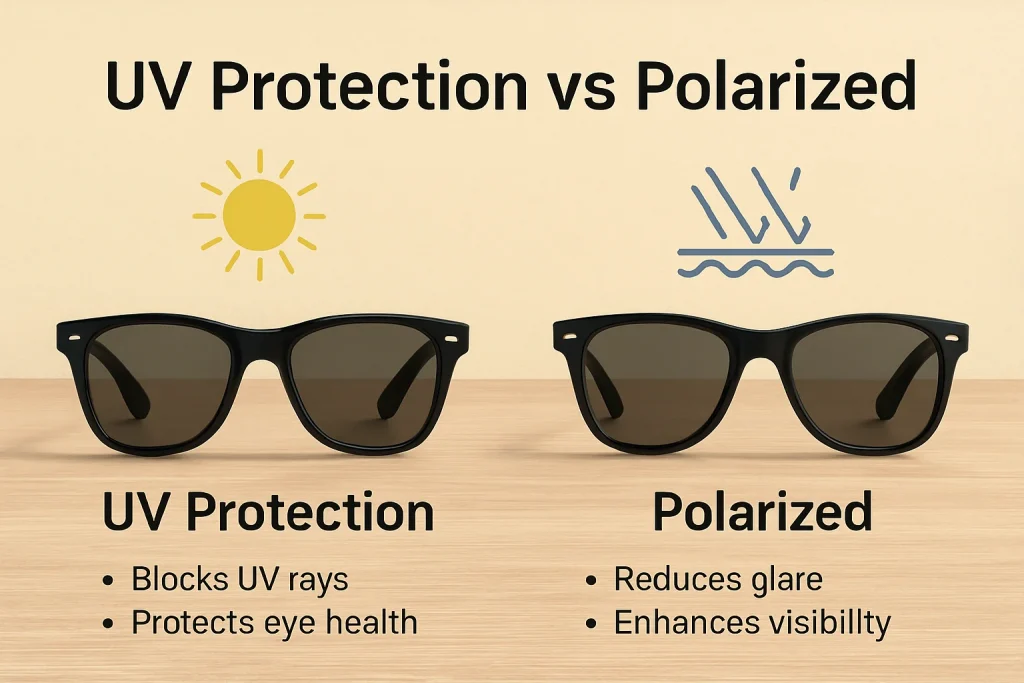UV and polarization are not the same but both are important for your eyes. UV blocks the bad rays while polarization reduces glare and makes it more comfortable to look.
When buying sunglasses think how you will use them. For basic eye safety UV is a must. If you drive a lot or spend time around water or snow then polarization is a good choice. If possible get sunglasses that has both for total protection and comfort.
Your eyes are sensitive and worth taking care of. Investing in good quality sunglasses not only makes you see better outdoors but also protects your vision in the long run.
What is UV Protection in Sunglasses?
UV protection in sunglasses is all about keeping your eyes safe from the sun’s harmful ultraviolet rays. These rays come in two main types—UVA and UVB. UVA rays can speed up eye aging and may lead to long-term damage, while UVB rays can cause more immediate harm, such as irritation, redness, or even sunburn to the cornea.

Sunglasses with UV protection are made with special lens coatings or materials that block these rays from reaching your eyes.
This protection helps prevent conditions like cataracts, macular degeneration, and other eye problems that can develop over time from too much sun exposure.
When shopping for sunglasses, look for a UV400 label. This means the lenses block 100 percent of UVA and UVB rays. It is the highest level of protection available and the safest choice for your eyes.
Wearing UV-blocking sunglasses is important for anyone who spends time outdoors—whether you are driving, walking, or relaxing at the beach. Over time, this protection can reduce the risk of serious eye conditions and keep your vision sharp and healthy. So even if the sun doesn’t feel harsh, your eyes still need that invisible layer of defense.
What are Polarized Sunglasses?
Polarized sunglasses are designed to reduce glare, which is the harsh light that reflects off flat surfaces like roads, water, glass or snow. Glare can make it hard to see and even cause eye strain or discomfort.
Polarization works by using a special filter in the lenses that blocks horizontal light waves. These are the waves that create glare when sunlight bounces off shiny or flat surfaces. By blocking this glare, polarized lenses help you see more clearly and comfortably, especially in bright conditions.
The benefits of polarized sunglasses go beyond just blocking glare. They offer sharper vision, better contrast and reduced eye fatigue. Colors may also appear more vivid and your eyes feel less tired after long periods in the sun.

These lenses are especially helpful for people who spend a lot of time outdoors. They are perfect for driving, boating, fishing, skiing and other activities where glare can be distracting or dangerous. But they’re not always ideal for looking at digital screens or in low light conditions as they can make it harder to see details.
If you want comfort and clarity in bright environments, polarized sunglasses can make a big difference in how you see the world.
UV Protection vs Polarized Lenses: Key Differences
While UV protection and polarization are both important features in sunglasses, they serve very different purposes. Understanding the difference will help you choose the right pair for your needs.
UV protection blocks harmful ultraviolet rays from the sun. These rays can damage your eyes over time and increase the risk of cataracts, macular degeneration and other serious eye problems. UV protection is essential for your long term eye health, even on cloudy days when UV rays still reach your eyes.
Polarized lenses do not protect against UV rays. They reduce glare by filtering out reflected light from flat surfaces like water, roads or snow. This makes your vision clearer and more comfortable, especially in bright or reflective environments.
It’s important to know that not all polarized sunglasses offer UV protection and not all UV blocking sunglasses are polarized.
Some cheaper sunglasses may even darken your view without providing any real protection at all.So look for sunglasses that offer UV protection and polarization. This way you protect your eyes and get sharper glare free vision. For anyone who’s outdoors this is the ultimate combination of comfort and safety.
Which Type of Sunglasses Do You Need?
Choosing the right type of sunglasses depends on how and where you plan to use them. Start by thinking about your daily routine, outdoor activities, and the environments you’re exposed to.
If you spend a lot of time outdoors—whether walking, commuting, or relaxing—UV protection is a must. It helps shield your eyes from harmful rays that can cause long-term damage. This applies even on cloudy days, since UV rays can still reach your eyes.
If you often deal with glare, such as when driving, fishing, boating, or skiing, polarized lenses are extremely helpful. They reduce reflections from water, roads, and snow, making your vision clearer and more comfortable.
For everyday use, sunglasses with UV protection should be your top priority. But if you are into outdoor sports, beach trips, or mountain activities, go for sunglasses that offer both UV and polarized lenses.
Your climate and surroundings also matter. In bright, sunny places or near water, glare and UV exposure are both strong. In such cases, having both features in one pair is ideal.
If your budget allows, choose sunglasses that combine UV protection with polarization. They offer complete coverage for both eye safety and visual clarity, making them the best all-around choice for most people.
How to Check if Your Sunglasses Offer Real UV or Polarized Protection
Before buying sunglasses, it is important to make sure they actually protect your eyes. Start by checking the product label or tag. Look for a UV400 mark, which means the lenses block 100 percent of harmful UVA and UVB rays. If there is no clear mention of UV protection, it is best not to buy them.
To test for polarization, you can do a simple trick. Hold the sunglasses in front of a digital screen, like a phone or calculator, and rotate them slowly. If the screen darkens or changes in brightness at certain angles, the lenses are polarized.
Some stores also provide polarization test cards or displays to help you confirm. You can also use free apps designed to test lens features, although results may vary.
Be cautious with very cheap sunglasses, especially from unverified sellers. Dark lenses without UV protection can actually make things worse by causing your pupils to dilate, letting in more harmful rays.
Always choose sunglasses from trusted brands or retailers to ensure your eyes are getting the proper protection they need.
Conclusion
UV and polarization are not the same but both are important for your eyes. UV helps block the harmful rays while polarization reduces glare and improves visual comfort.
When choosing sunglasses think about how you will use them. For basic eye safety UV is a must. If you drive a lot or spend time around water or snow then polarization is a good choice. If possible go for sunglasses that has both for complete protection and comfort.
Your eyes are sensitive and worth taking care of. Investing in good quality sunglasses not only improves how you see outdoors but also protects your vision in the long run.
FAQs
1. What is the difference between UV protection and polarized sunglasses?
UV protection blocks harmful ultraviolet rays from the sun, while polarized lenses reduce glare by filtering reflected light from surfaces like water and roads.
2. Do polarized sunglasses provide UV protection?
Not always. Some polarized sunglasses include UV protection, but not all do. Always check the label to ensure your sunglasses block 100% of UVA and UVB rays.
3. Why is UV protection important in sunglasses?
UV protection shields your eyes from harmful rays that can cause cataracts, macular degeneration, and other long-term eye damage.
4. How do polarized lenses reduce glare?
Polarized lenses use a special filter that blocks horizontal light waves, which are responsible for glare from flat, reflective surfaces.
5. Can I get sunglasses that offer both UV protection and polarization?
Yes, many high-quality sunglasses combine both features, offering full UV protection and glare reduction for optimal eye safety and comfort.
6. Are polarized sunglasses better for driving?
Yes, polarized lenses reduce glare from the road and other vehicles, improving visibility and reducing eye strain during driving.
7. How can I test if my sunglasses are polarized?
Hold your sunglasses in front of a digital screen and rotate them. If the screen darkens at certain angles, your lenses are polarized.
8. Can UV protection sunglasses be used indoors?
Yes, but they are mainly designed for outdoor use to protect against sun rays. Wearing them indoors is usually unnecessary unless you have specific light sensitivity.
9. Are cheap sunglasses without UV protection harmful?
Yes. Dark lenses without UV protection can cause your pupils to dilate, allowing more harmful rays to enter your eyes, which increases the risk of damage.


